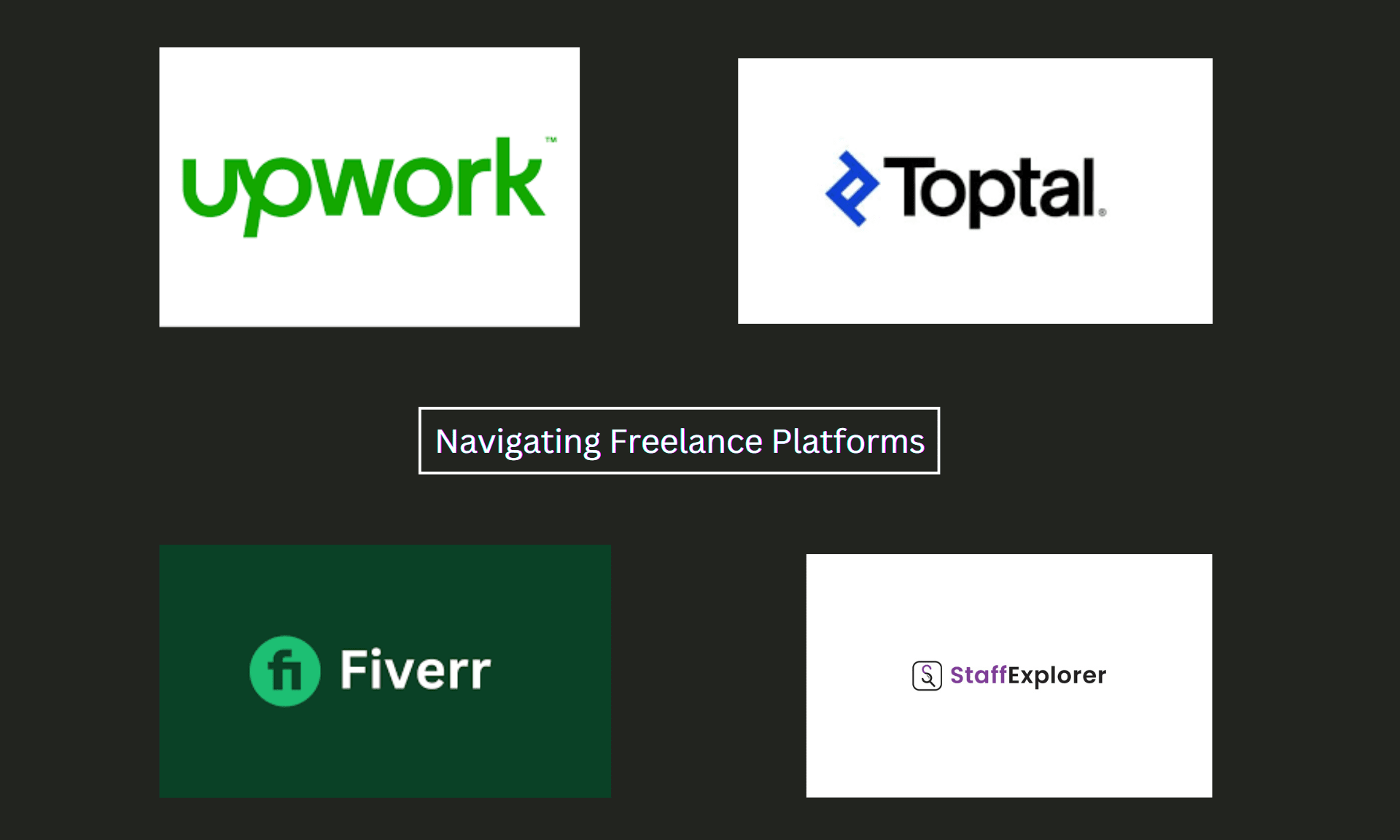The freelance economy is booming, with millions of professionals and businesses worldwide leveraging online platforms to connect. Whether you’re a freelancer seeking clients or a business searching for top-notch talent, freelance platforms like Upwork, Fiverr, Toptal, StaffExplorer, and others have become indispensable tools. However, effectively navigating these platforms requires strategy, knowledge, and optimization. This guide will help you master freelance platforms, focusing on essential tips, SEO strategies, and best practices to achieve your goals.
Understanding Freelance Platforms
Freelance platforms serve as digital marketplaces where freelancers and businesses meet to collaborate on various projects. These platforms are crucial for several reasons:
- Global Access: Connect with clients and freelancers worldwide.
- Diverse Opportunities: From graphic design to software development, freelance platforms cater to virtually every industry.
- Flexibility: Freelancers can work on their terms, while businesses can find tailored solutions for their projects.
Popular Freelance Platforms
- Upwork: Ideal for a wide range of projects, from small tasks to long-term contracts.
- Fiverr: Best for microtasks and creative gigs, with a simple gig-based pricing model.
- Freelancer: Offers flexibility with both fixed-price and hourly projects, plus contests.
- Toptal: Known for its exclusivity and high-quality talent, catering to premium clients.
- Staffexplorer: A growing platform designed for businesses seeking remote professionals across various fields, offering competitive pricing and flexible solutions.
How to Create a Winning Freelance Profile
Your profile on a freelance platform is your digital resume. A well-crafted profile not only attracts clients but also improves visibility on the platform’s search engine.
1. Use Keywords Strategically
Keywords are crucial for SEO within freelance platforms. To identify the best keywords:
- Use tools like Google Keyword Planner or platform-specific searches.
- Focus on phrases clients search for, e.g., “SEO content writer,” “WordPress developer,” or “social media strategist.”
2. Craft an Engaging Headline
Your headline is one of the first things potential clients see. Make it concise, specific, and keyword-rich. For example:
- Instead of: “Writer Available”
- Use: “SEO Content Writer Specializing in Tech and Marketing”
3. Optimize Your About Section
The “About” section is your chance to shine. Write a compelling summary of your skills, experience, and achievements. Include:
- Relevant keywords.
- Bullet points for readability.
- A clear call-to-action, like “Let’s bring your vision to life—contact me today!”
4. Showcase a Stellar Portfolio
Portfolios are visual proof of your expertise. Include:
- High-quality samples relevant to your niche.
- Descriptive captions with keywords.
- Updated projects to reflect your current skills.
How to Stand Out as a Freelancer

Freelance platforms are competitive. To succeed, you need more than just a strong profile—you need a strategy.
1. Specialize in a Niche
Generalists often struggle to compete with specialists. By focusing on a niche, you:
- Reduce competition.
- Position yourself as an expert.
- Attract higher-paying clients.
For example, instead of branding yourself as a general “writer,” market yourself as a “finance blog writer specializing in cryptocurrency and blockchain.”
2. Write Tailored Proposals
When applying for jobs:
- Personalize each proposal to address the client’s specific needs.
- Use a professional tone and clear language.
- Highlight your unique value proposition (e.g., “I’ve helped similar businesses achieve XYZ results.”).
3. Leverage Reviews and Ratings
Positive reviews and high ratings build trust and improve your profile’s visibility. To gain them:
- Deliver exceptional work.
- Communicate clearly and promptly.
- Politely request feedback after completing a project.
How Clients Can Attract Top Freelancers
For businesses, finding the right freelancer is crucial to project success. An optimized job post ensures you attract qualified candidates.
1. Write Clear Job Titles
Job titles should be specific and keyword-rich. For instance:
- Instead of: “Need Designer”
- Use: “Seeking Experienced UI/UX Designer for Mobile App”
2. Provide Detailed Descriptions
A well-crafted description sets clear expectations and attracts the right candidates. Include:
- Project objectives and deliverables.
- Required skills and qualifications.
- Budget range and timeline.
3. Use Skill Tags and Categories
Most platforms allow you to tag job posts with relevant skills. Accurate tagging helps your post appear in the right search results.
READ ALSO: Tips for Hiring Freelancers That Won’t Disappoint
SEO Strategies for Freelancers and Clients
Optimizing your profile or job post for search engines—both within platforms and externally—can drastically improve visibility and engagement.
1. Research Keywords
Use tools like SEMrush, Ubersuggest, or Ahrefs to identify high-ranking keywords in your industry. Focus on:
- Long-tail keywords (e.g., “affordable logo designer for startups”).
- Keywords with moderate competition and high search volume.
2. Optimize Titles and Descriptions
Whether it’s your profile headline or a job title, ensure it includes primary keywords naturally. Avoid keyword stuffing, as this can harm your ranking.
3. Leverage External Traffic
Boost your platform visibility by driving traffic from external sources:
- Share your profile or job post on LinkedIn, Twitter, and other social media.
- Use backlinks from blogs or personal websites to improve your SEO ranking.
Comparing Freelance Platforms: Which One is Right for You?
1. Upwork
- Pros: Broad range of categories, advanced vetting.
- Cons: High competition; fees (5-20%).
- Best For: Long-term projects and professional services.
2. Fiverr
- Pros: Easy to use; gig packages simplify pricing.
- Cons: Limited scope for complex projects.
- Best For: Quick, creative tasks and microservices.
3. Toptal
- Pros: Elite talent pool; high-quality clients.
- Cons: Exclusive and competitive.
- Best For: Experienced professionals in tech, design, and finance.
4. Freelancer
- Pros: Flexible payment options; project contests.
- Cons: Platform fees; varying project legitimacy.
- Best For: Businesses looking for diverse solutions and freelancers seeking contests.
5. StaffExplorer.com
- Pros: Focused on providing African remote talent for businesses; competitive pricing and scalable solutions.
- Cons: Still growing its freelancer base compared to more established platforms.
- Best For: Businesses looking for dedicated remote teams and freelancers offering administrative, IT, or customer support services.
Trends Shaping Freelance Platforms
1. AI Integration
Freelance platforms are increasingly leveraging AI to:
- Match freelancers with jobs based on skills and past performance.
- Provide insights for profile and proposal optimization.
2. Specialization
Niche platforms like Behance (for designers) and GitHub (for developers) are gaining traction. Freelancers with specialized skills should explore these platforms for targeted opportunities.
3. Remote Work Evolution
As remote work becomes mainstream, freelancers and clients should prioritize tools and practices that enhance collaboration, like project management software and clear communication protocols.
Common Challenges and Solutions

1. Overcoming High Competition
Freelancers can:
- Build expertise in a specific niche.
- Invest in certifications or courses to enhance skills.
2. Managing Fees
Platform fees can reduce profitability. To mitigate this:
- Include fees in your pricing.
- Move repeat clients off-platform (if permitted).
3. Ensuring Clear Communication
Both parties should:
- Set expectations upfront.
- Use milestones and regular updates to track progress.
Measuring Success on Freelance Platforms
Tracking performance helps freelancers and clients refine their strategies over time.
For Freelancers:
- Profile Views: Indicates how often your profile appears in searches.
- Proposal Success Rate: Tracks how many proposals result in jobs.
- Client Retention: Reflects the quality of your work and relationships.
For Clients:
- Application Quality: Measures how closely applicants meet job requirements.
- Project Completion Rate: Indicates successful delivery.
- Freelancer Satisfaction: Assesses how well freelancers meet expectations.
Key Takeaways
Navigating freelance platforms effectively requires a combination of strategic decision-making, and clear communication. Freelancers can boost their visibility and secure high-quality projects by optimizing profiles, specializing in niches, and delivering outstanding work. Similarly, clients can attract top talent by crafting detailed job posts and leveraging platform tools.
As freelance platforms evolve, staying informed about trends, tools, and best practices will ensure continued success. Whether you’re a freelancer or a client, mastering these platforms—including StaffExplorer—will unlock opportunities in today’s dynamic gig economy.
Let these tips be your roadmap to thriving on freelance platforms—no matter where you are on your journey!

Leave your comment